Holmes Institute Business and Corporate Law Case Study Report
VerifiedAdded on 2022/12/20
|9
|2585
|4
Report
AI Summary
This report presents solutions to two case studies in business and corporate law. The first case examines contract law principles, including offer, acceptance, consideration, and the enforceability of unilateral offers in the context of an advertisement. It analyzes the rights and obligations of parties involved, referencing relevant legal precedents. The second case delves into company law, focusing on the legal status of companies, pre-registration contracts, and the application of the Corporations Act 2001 concerning dealings with outsiders and the authority of directors. The report applies legal principles to the facts of each case, providing a comprehensive analysis and conclusion for each.

1
Title page
Name of the student
Student ID
Title page
Name of the student
Student ID
Paraphrase This Document
Need a fresh take? Get an instant paraphrase of this document with our AI Paraphraser
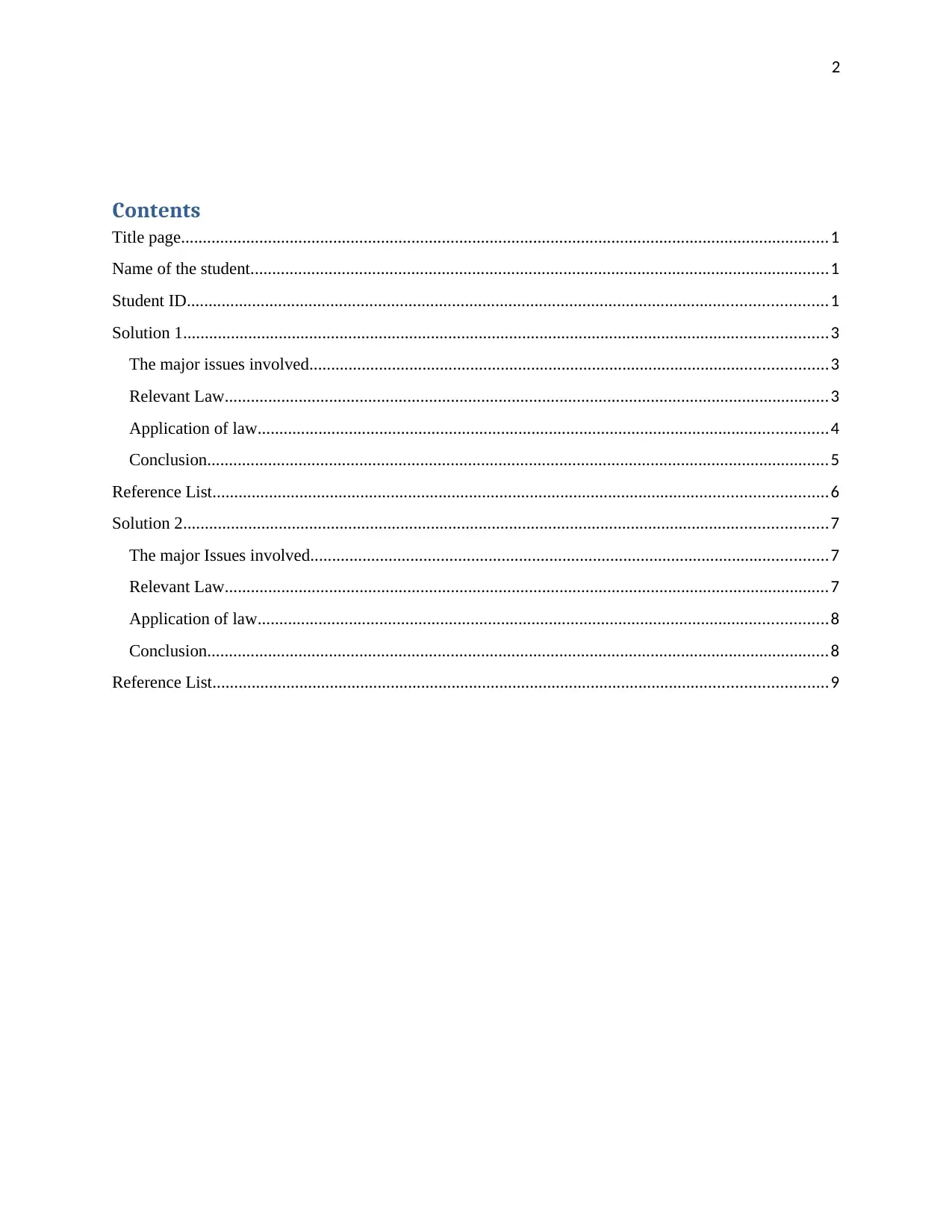
2
Contents
Title page.....................................................................................................................................................1
Name of the student.....................................................................................................................................1
Student ID...................................................................................................................................................1
Solution 1....................................................................................................................................................3
The major issues involved.......................................................................................................................3
Relevant Law...........................................................................................................................................3
Application of law...................................................................................................................................4
Conclusion...............................................................................................................................................5
Reference List.............................................................................................................................................6
Solution 2....................................................................................................................................................7
The major Issues involved.......................................................................................................................7
Relevant Law...........................................................................................................................................7
Application of law...................................................................................................................................8
Conclusion...............................................................................................................................................8
Reference List.............................................................................................................................................9
Contents
Title page.....................................................................................................................................................1
Name of the student.....................................................................................................................................1
Student ID...................................................................................................................................................1
Solution 1....................................................................................................................................................3
The major issues involved.......................................................................................................................3
Relevant Law...........................................................................................................................................3
Application of law...................................................................................................................................4
Conclusion...............................................................................................................................................5
Reference List.............................................................................................................................................6
Solution 2....................................................................................................................................................7
The major Issues involved.......................................................................................................................7
Relevant Law...........................................................................................................................................7
Application of law...................................................................................................................................8
Conclusion...............................................................................................................................................8
Reference List.............................................................................................................................................9
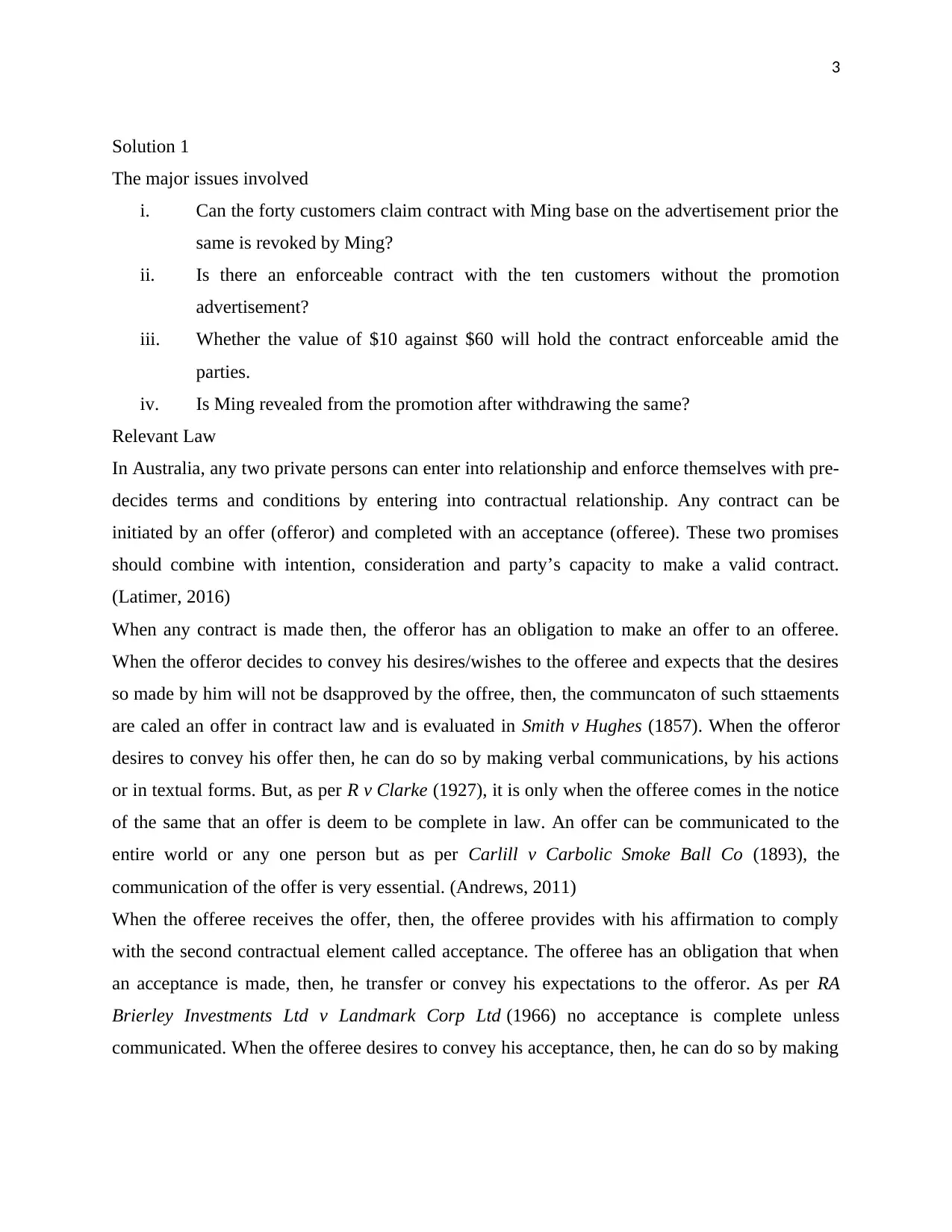
3
Solution 1
The major issues involved
i. Can the forty customers claim contract with Ming base on the advertisement prior the
same is revoked by Ming?
ii. Is there an enforceable contract with the ten customers without the promotion
advertisement?
iii. Whether the value of $10 against $60 will hold the contract enforceable amid the
parties.
iv. Is Ming revealed from the promotion after withdrawing the same?
Relevant Law
In Australia, any two private persons can enter into relationship and enforce themselves with pre-
decides terms and conditions by entering into contractual relationship. Any contract can be
initiated by an offer (offeror) and completed with an acceptance (offeree). These two promises
should combine with intention, consideration and party’s capacity to make a valid contract.
(Latimer, 2016)
When any contract is made then, the offeror has an obligation to make an offer to an offeree.
When the offeror decides to convey his desires/wishes to the offeree and expects that the desires
so made by him will not be dsapproved by the offree, then, the communcaton of such sttaements
are caled an offer in contract law and is evaluated in Smith v Hughes (1857). When the offeror
desires to convey his offer then, he can do so by making verbal communications, by his actions
or in textual forms. But, as per R v Clarke (1927), it is only when the offeree comes in the notice
of the same that an offer is deem to be complete in law. An offer can be communicated to the
entire world or any one person but as per Carlill v Carbolic Smoke Ball Co (1893), the
communication of the offer is very essential. (Andrews, 2011)
When the offeree receives the offer, then, the offeree provides with his affirmation to comply
with the second contractual element called acceptance. The offeree has an obligation that when
an acceptance is made, then, he transfer or convey his expectations to the offeror. As per RA
Brierley Investments Ltd v Landmark Corp Ltd (1966) no acceptance is complete unless
communicated. When the offeree desires to convey his acceptance, then, he can do so by making
Solution 1
The major issues involved
i. Can the forty customers claim contract with Ming base on the advertisement prior the
same is revoked by Ming?
ii. Is there an enforceable contract with the ten customers without the promotion
advertisement?
iii. Whether the value of $10 against $60 will hold the contract enforceable amid the
parties.
iv. Is Ming revealed from the promotion after withdrawing the same?
Relevant Law
In Australia, any two private persons can enter into relationship and enforce themselves with pre-
decides terms and conditions by entering into contractual relationship. Any contract can be
initiated by an offer (offeror) and completed with an acceptance (offeree). These two promises
should combine with intention, consideration and party’s capacity to make a valid contract.
(Latimer, 2016)
When any contract is made then, the offeror has an obligation to make an offer to an offeree.
When the offeror decides to convey his desires/wishes to the offeree and expects that the desires
so made by him will not be dsapproved by the offree, then, the communcaton of such sttaements
are caled an offer in contract law and is evaluated in Smith v Hughes (1857). When the offeror
desires to convey his offer then, he can do so by making verbal communications, by his actions
or in textual forms. But, as per R v Clarke (1927), it is only when the offeree comes in the notice
of the same that an offer is deem to be complete in law. An offer can be communicated to the
entire world or any one person but as per Carlill v Carbolic Smoke Ball Co (1893), the
communication of the offer is very essential. (Andrews, 2011)
When the offeree receives the offer, then, the offeree provides with his affirmation to comply
with the second contractual element called acceptance. The offeree has an obligation that when
an acceptance is made, then, he transfer or convey his expectations to the offeror. As per RA
Brierley Investments Ltd v Landmark Corp Ltd (1966) no acceptance is complete unless
communicated. When the offeree desires to convey his acceptance, then, he can do so by making
⊘ This is a preview!⊘
Do you want full access?
Subscribe today to unlock all pages.

Trusted by 1+ million students worldwide
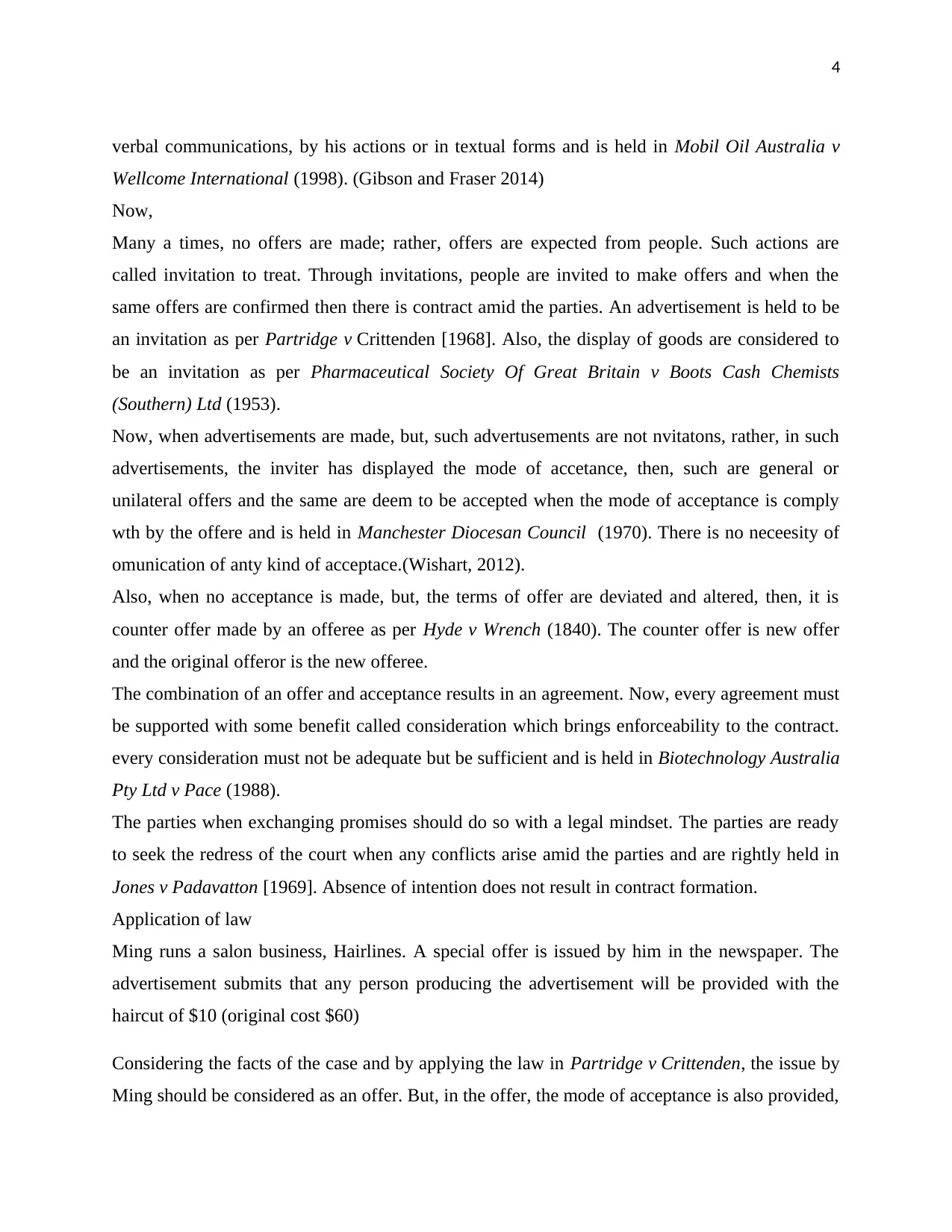
4
verbal communications, by his actions or in textual forms and is held in Mobil Oil Australia v
Wellcome International (1998). (Gibson and Fraser 2014)
Now,
Many a times, no offers are made; rather, offers are expected from people. Such actions are
called invitation to treat. Through invitations, people are invited to make offers and when the
same offers are confirmed then there is contract amid the parties. An advertisement is held to be
an invitation as per Partridge v Crittenden [1968]. Also, the display of goods are considered to
be an invitation as per Pharmaceutical Society Of Great Britain v Boots Cash Chemists
(Southern) Ltd (1953).
Now, when advertisements are made, but, such advertusements are not nvitatons, rather, in such
advertisements, the inviter has displayed the mode of accetance, then, such are general or
unilateral offers and the same are deem to be accepted when the mode of acceptance is comply
wth by the offere and is held in Manchester Diocesan Council (1970). There is no neceesity of
omunication of anty kind of acceptace.(Wishart, 2012).
Also, when no acceptance is made, but, the terms of offer are deviated and altered, then, it is
counter offer made by an offeree as per Hyde v Wrench (1840). The counter offer is new offer
and the original offeror is the new offeree.
The combination of an offer and acceptance results in an agreement. Now, every agreement must
be supported with some benefit called consideration which brings enforceability to the contract.
every consideration must not be adequate but be sufficient and is held in Biotechnology Australia
Pty Ltd v Pace (1988).
The parties when exchanging promises should do so with a legal mindset. The parties are ready
to seek the redress of the court when any conflicts arise amid the parties and are rightly held in
Jones v Padavatton [1969]. Absence of intention does not result in contract formation.
Application of law
Ming runs a salon business, Hairlines. A special offer is issued by him in the newspaper. The
advertisement submits that any person producing the advertisement will be provided with the
haircut of $10 (original cost $60)
Considering the facts of the case and by applying the law in Partridge v Crittenden, the issue by
Ming should be considered as an offer. But, in the offer, the mode of acceptance is also provided,
verbal communications, by his actions or in textual forms and is held in Mobil Oil Australia v
Wellcome International (1998). (Gibson and Fraser 2014)
Now,
Many a times, no offers are made; rather, offers are expected from people. Such actions are
called invitation to treat. Through invitations, people are invited to make offers and when the
same offers are confirmed then there is contract amid the parties. An advertisement is held to be
an invitation as per Partridge v Crittenden [1968]. Also, the display of goods are considered to
be an invitation as per Pharmaceutical Society Of Great Britain v Boots Cash Chemists
(Southern) Ltd (1953).
Now, when advertisements are made, but, such advertusements are not nvitatons, rather, in such
advertisements, the inviter has displayed the mode of accetance, then, such are general or
unilateral offers and the same are deem to be accepted when the mode of acceptance is comply
wth by the offere and is held in Manchester Diocesan Council (1970). There is no neceesity of
omunication of anty kind of acceptace.(Wishart, 2012).
Also, when no acceptance is made, but, the terms of offer are deviated and altered, then, it is
counter offer made by an offeree as per Hyde v Wrench (1840). The counter offer is new offer
and the original offeror is the new offeree.
The combination of an offer and acceptance results in an agreement. Now, every agreement must
be supported with some benefit called consideration which brings enforceability to the contract.
every consideration must not be adequate but be sufficient and is held in Biotechnology Australia
Pty Ltd v Pace (1988).
The parties when exchanging promises should do so with a legal mindset. The parties are ready
to seek the redress of the court when any conflicts arise amid the parties and are rightly held in
Jones v Padavatton [1969]. Absence of intention does not result in contract formation.
Application of law
Ming runs a salon business, Hairlines. A special offer is issued by him in the newspaper. The
advertisement submits that any person producing the advertisement will be provided with the
haircut of $10 (original cost $60)
Considering the facts of the case and by applying the law in Partridge v Crittenden, the issue by
Ming should be considered as an offer. But, in the offer, the mode of acceptance is also provided,
Paraphrase This Document
Need a fresh take? Get an instant paraphrase of this document with our AI Paraphraser
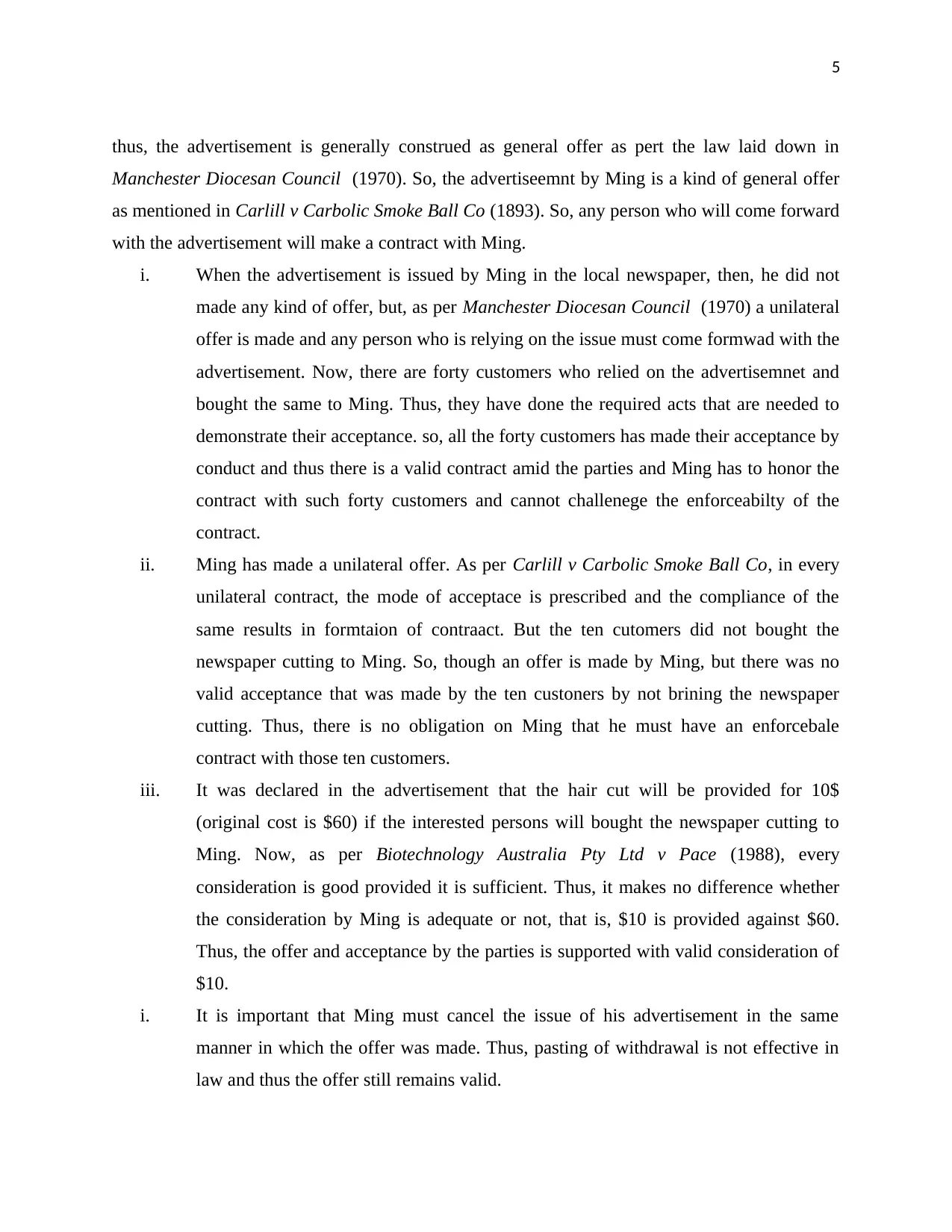
5
thus, the advertisement is generally construed as general offer as pert the law laid down in
Manchester Diocesan Council (1970). So, the advertiseemnt by Ming is a kind of general offer
as mentioned in Carlill v Carbolic Smoke Ball Co (1893). So, any person who will come forward
with the advertisement will make a contract with Ming.
i. When the advertisement is issued by Ming in the local newspaper, then, he did not
made any kind of offer, but, as per Manchester Diocesan Council (1970) a unilateral
offer is made and any person who is relying on the issue must come formwad with the
advertisement. Now, there are forty customers who relied on the advertisemnet and
bought the same to Ming. Thus, they have done the required acts that are needed to
demonstrate their acceptance. so, all the forty customers has made their acceptance by
conduct and thus there is a valid contract amid the parties and Ming has to honor the
contract with such forty customers and cannot challenege the enforceabilty of the
contract.
ii. Ming has made a unilateral offer. As per Carlill v Carbolic Smoke Ball Co, in every
unilateral contract, the mode of acceptace is prescribed and the compliance of the
same results in formtaion of contraact. But the ten cutomers did not bought the
newspaper cutting to Ming. So, though an offer is made by Ming, but there was no
valid acceptance that was made by the ten custoners by not brining the newspaper
cutting. Thus, there is no obligation on Ming that he must have an enforcebale
contract with those ten customers.
iii. It was declared in the advertisement that the hair cut will be provided for 10$
(original cost is $60) if the interested persons will bought the newspaper cutting to
Ming. Now, as per Biotechnology Australia Pty Ltd v Pace (1988), every
consideration is good provided it is sufficient. Thus, it makes no difference whether
the consideration by Ming is adequate or not, that is, $10 is provided against $60.
Thus, the offer and acceptance by the parties is supported with valid consideration of
$10.
i. It is important that Ming must cancel the issue of his advertisement in the same
manner in which the offer was made. Thus, pasting of withdrawal is not effective in
law and thus the offer still remains valid.
thus, the advertisement is generally construed as general offer as pert the law laid down in
Manchester Diocesan Council (1970). So, the advertiseemnt by Ming is a kind of general offer
as mentioned in Carlill v Carbolic Smoke Ball Co (1893). So, any person who will come forward
with the advertisement will make a contract with Ming.
i. When the advertisement is issued by Ming in the local newspaper, then, he did not
made any kind of offer, but, as per Manchester Diocesan Council (1970) a unilateral
offer is made and any person who is relying on the issue must come formwad with the
advertisement. Now, there are forty customers who relied on the advertisemnet and
bought the same to Ming. Thus, they have done the required acts that are needed to
demonstrate their acceptance. so, all the forty customers has made their acceptance by
conduct and thus there is a valid contract amid the parties and Ming has to honor the
contract with such forty customers and cannot challenege the enforceabilty of the
contract.
ii. Ming has made a unilateral offer. As per Carlill v Carbolic Smoke Ball Co, in every
unilateral contract, the mode of acceptace is prescribed and the compliance of the
same results in formtaion of contraact. But the ten cutomers did not bought the
newspaper cutting to Ming. So, though an offer is made by Ming, but there was no
valid acceptance that was made by the ten custoners by not brining the newspaper
cutting. Thus, there is no obligation on Ming that he must have an enforcebale
contract with those ten customers.
iii. It was declared in the advertisement that the hair cut will be provided for 10$
(original cost is $60) if the interested persons will bought the newspaper cutting to
Ming. Now, as per Biotechnology Australia Pty Ltd v Pace (1988), every
consideration is good provided it is sufficient. Thus, it makes no difference whether
the consideration by Ming is adequate or not, that is, $10 is provided against $60.
Thus, the offer and acceptance by the parties is supported with valid consideration of
$10.
i. It is important that Ming must cancel the issue of his advertisement in the same
manner in which the offer was made. Thus, pasting of withdrawal is not effective in
law and thus the offer still remains valid.
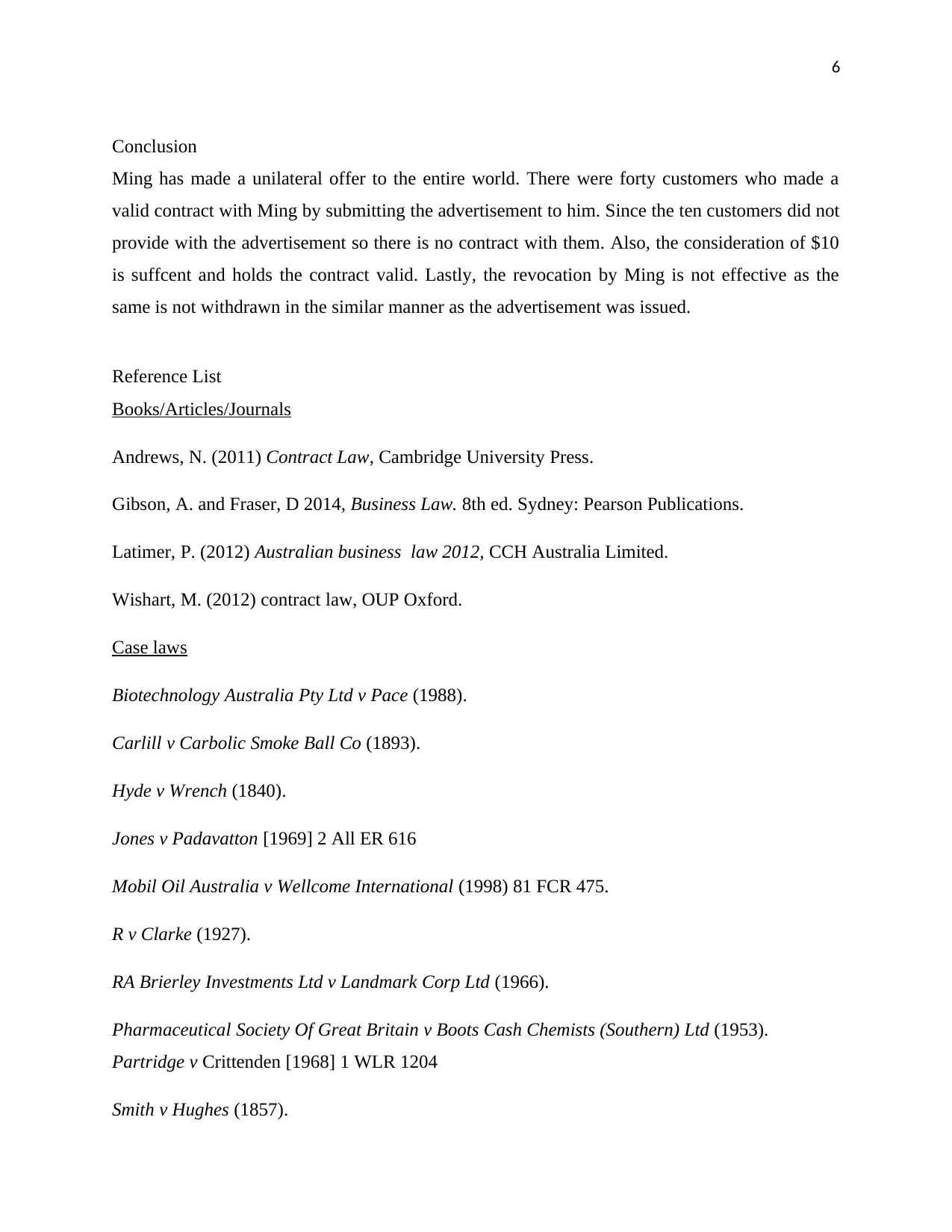
6
Conclusion
Ming has made a unilateral offer to the entire world. There were forty customers who made a
valid contract with Ming by submitting the advertisement to him. Since the ten customers did not
provide with the advertisement so there is no contract with them. Also, the consideration of $10
is suffcent and holds the contract valid. Lastly, the revocation by Ming is not effective as the
same is not withdrawn in the similar manner as the advertisement was issued.
Reference List
Books/Articles/Journals
Andrews, N. (2011) Contract Law, Cambridge University Press.
Gibson, A. and Fraser, D 2014, Business Law. 8th ed. Sydney: Pearson Publications.
Latimer, P. (2012) Australian business law 2012, CCH Australia Limited.
Wishart, M. (2012) contract law, OUP Oxford.
Case laws
Biotechnology Australia Pty Ltd v Pace (1988).
Carlill v Carbolic Smoke Ball Co (1893).
Hyde v Wrench (1840).
Jones v Padavatton [1969] 2 All ER 616
Mobil Oil Australia v Wellcome International (1998) 81 FCR 475.
R v Clarke (1927).
RA Brierley Investments Ltd v Landmark Corp Ltd (1966).
Pharmaceutical Society Of Great Britain v Boots Cash Chemists (Southern) Ltd (1953).
Partridge v Crittenden [1968] 1 WLR 1204
Smith v Hughes (1857).
Conclusion
Ming has made a unilateral offer to the entire world. There were forty customers who made a
valid contract with Ming by submitting the advertisement to him. Since the ten customers did not
provide with the advertisement so there is no contract with them. Also, the consideration of $10
is suffcent and holds the contract valid. Lastly, the revocation by Ming is not effective as the
same is not withdrawn in the similar manner as the advertisement was issued.
Reference List
Books/Articles/Journals
Andrews, N. (2011) Contract Law, Cambridge University Press.
Gibson, A. and Fraser, D 2014, Business Law. 8th ed. Sydney: Pearson Publications.
Latimer, P. (2012) Australian business law 2012, CCH Australia Limited.
Wishart, M. (2012) contract law, OUP Oxford.
Case laws
Biotechnology Australia Pty Ltd v Pace (1988).
Carlill v Carbolic Smoke Ball Co (1893).
Hyde v Wrench (1840).
Jones v Padavatton [1969] 2 All ER 616
Mobil Oil Australia v Wellcome International (1998) 81 FCR 475.
R v Clarke (1927).
RA Brierley Investments Ltd v Landmark Corp Ltd (1966).
Pharmaceutical Society Of Great Britain v Boots Cash Chemists (Southern) Ltd (1953).
Partridge v Crittenden [1968] 1 WLR 1204
Smith v Hughes (1857).
⊘ This is a preview!⊘
Do you want full access?
Subscribe today to unlock all pages.

Trusted by 1+ million students worldwide
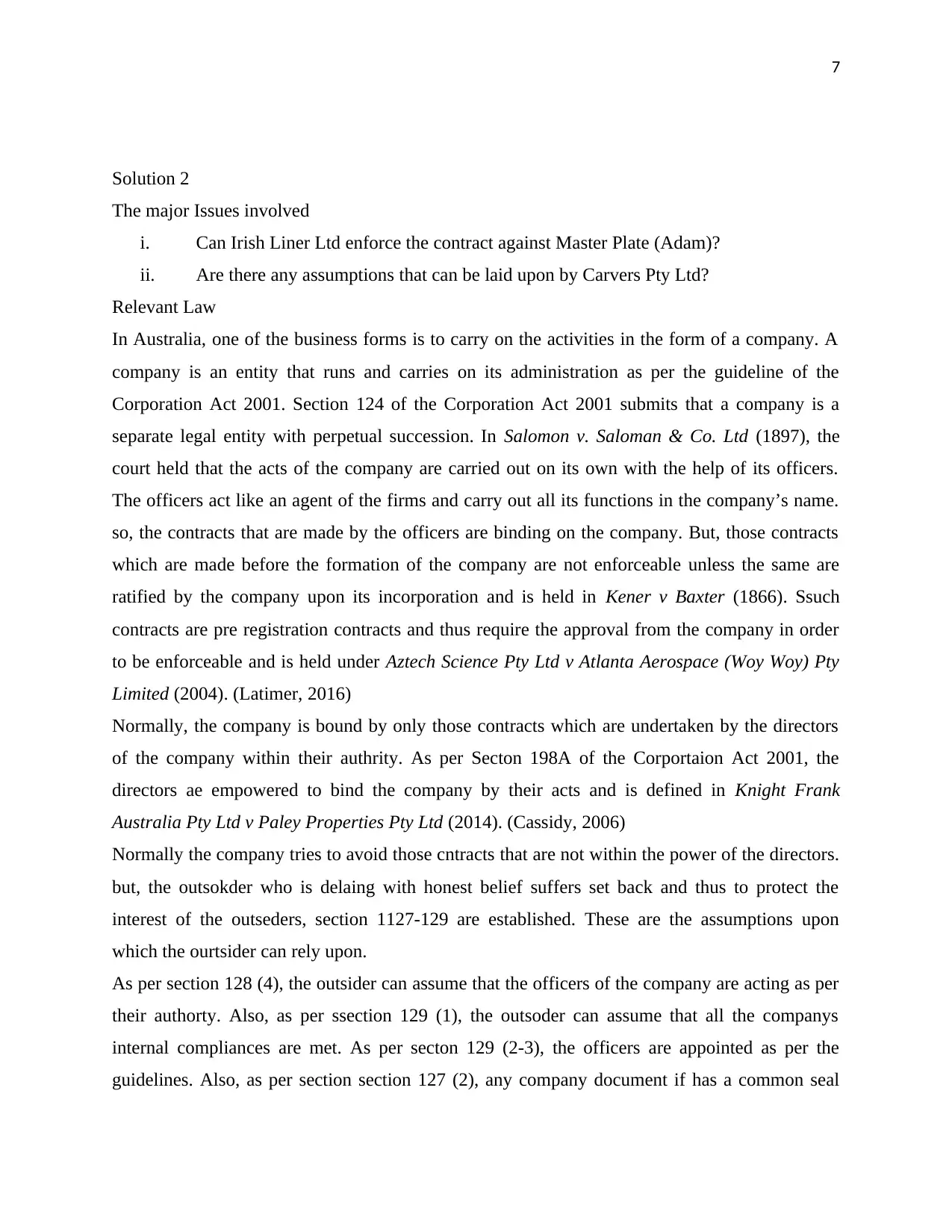
7
Solution 2
The major Issues involved
i. Can Irish Liner Ltd enforce the contract against Master Plate (Adam)?
ii. Are there any assumptions that can be laid upon by Carvers Pty Ltd?
Relevant Law
In Australia, one of the business forms is to carry on the activities in the form of a company. A
company is an entity that runs and carries on its administration as per the guideline of the
Corporation Act 2001. Section 124 of the Corporation Act 2001 submits that a company is a
separate legal entity with perpetual succession. In Salomon v. Saloman & Co. Ltd (1897), the
court held that the acts of the company are carried out on its own with the help of its officers.
The officers act like an agent of the firms and carry out all its functions in the company’s name.
so, the contracts that are made by the officers are binding on the company. But, those contracts
which are made before the formation of the company are not enforceable unless the same are
ratified by the company upon its incorporation and is held in Kener v Baxter (1866). Ssuch
contracts are pre registration contracts and thus require the approval from the company in order
to be enforceable and is held under Aztech Science Pty Ltd v Atlanta Aerospace (Woy Woy) Pty
Limited (2004). (Latimer, 2016)
Normally, the company is bound by only those contracts which are undertaken by the directors
of the company within their authrity. As per Secton 198A of the Corportaion Act 2001, the
directors ae empowered to bind the company by their acts and is defined in Knight Frank
Australia Pty Ltd v Paley Properties Pty Ltd (2014). (Cassidy, 2006)
Normally the company tries to avoid those cntracts that are not within the power of the directors.
but, the outsokder who is delaing with honest belief suffers set back and thus to protect the
interest of the outseders, section 1127-129 are established. These are the assumptions upon
which the ourtsider can rely upon.
As per section 128 (4), the outsider can assume that the officers of the company are acting as per
their authorty. Also, as per ssection 129 (1), the outsoder can assume that all the companys
internal compliances are met. As per secton 129 (2-3), the officers are appointed as per the
guidelines. Also, as per section section 127 (2), any company document if has a common seal
Solution 2
The major Issues involved
i. Can Irish Liner Ltd enforce the contract against Master Plate (Adam)?
ii. Are there any assumptions that can be laid upon by Carvers Pty Ltd?
Relevant Law
In Australia, one of the business forms is to carry on the activities in the form of a company. A
company is an entity that runs and carries on its administration as per the guideline of the
Corporation Act 2001. Section 124 of the Corporation Act 2001 submits that a company is a
separate legal entity with perpetual succession. In Salomon v. Saloman & Co. Ltd (1897), the
court held that the acts of the company are carried out on its own with the help of its officers.
The officers act like an agent of the firms and carry out all its functions in the company’s name.
so, the contracts that are made by the officers are binding on the company. But, those contracts
which are made before the formation of the company are not enforceable unless the same are
ratified by the company upon its incorporation and is held in Kener v Baxter (1866). Ssuch
contracts are pre registration contracts and thus require the approval from the company in order
to be enforceable and is held under Aztech Science Pty Ltd v Atlanta Aerospace (Woy Woy) Pty
Limited (2004). (Latimer, 2016)
Normally, the company is bound by only those contracts which are undertaken by the directors
of the company within their authrity. As per Secton 198A of the Corportaion Act 2001, the
directors ae empowered to bind the company by their acts and is defined in Knight Frank
Australia Pty Ltd v Paley Properties Pty Ltd (2014). (Cassidy, 2006)
Normally the company tries to avoid those cntracts that are not within the power of the directors.
but, the outsokder who is delaing with honest belief suffers set back and thus to protect the
interest of the outseders, section 1127-129 are established. These are the assumptions upon
which the ourtsider can rely upon.
As per section 128 (4), the outsider can assume that the officers of the company are acting as per
their authorty. Also, as per ssection 129 (1), the outsoder can assume that all the companys
internal compliances are met. As per secton 129 (2-3), the officers are appointed as per the
guidelines. Also, as per section section 127 (2), any company document if has a common seal
Paraphrase This Document
Need a fresh take? Get an instant paraphrase of this document with our AI Paraphraser
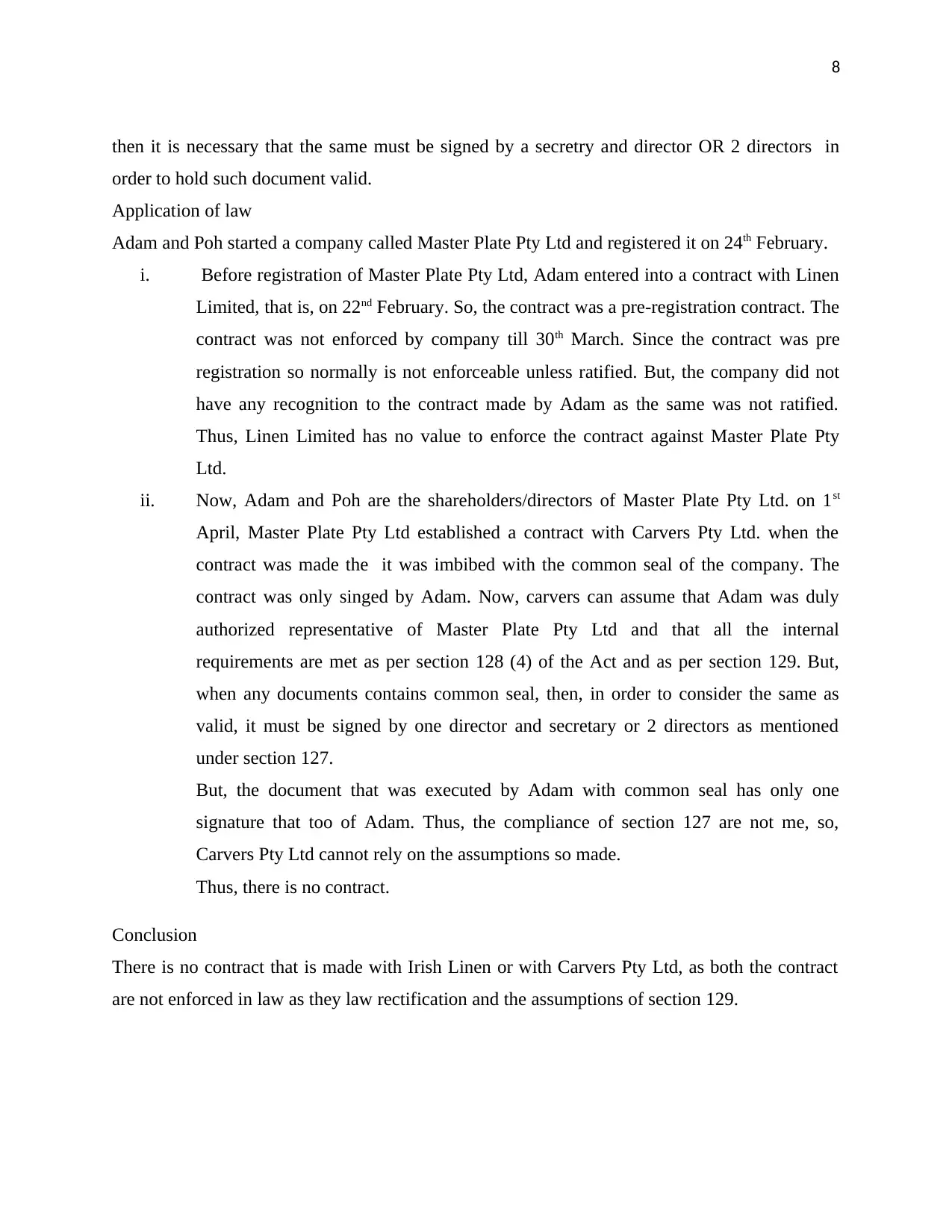
8
then it is necessary that the same must be signed by a secretry and director OR 2 directors in
order to hold such document valid.
Application of law
Adam and Poh started a company called Master Plate Pty Ltd and registered it on 24th February.
i. Before registration of Master Plate Pty Ltd, Adam entered into a contract with Linen
Limited, that is, on 22nd February. So, the contract was a pre-registration contract. The
contract was not enforced by company till 30th March. Since the contract was pre
registration so normally is not enforceable unless ratified. But, the company did not
have any recognition to the contract made by Adam as the same was not ratified.
Thus, Linen Limited has no value to enforce the contract against Master Plate Pty
Ltd.
ii. Now, Adam and Poh are the shareholders/directors of Master Plate Pty Ltd. on 1st
April, Master Plate Pty Ltd established a contract with Carvers Pty Ltd. when the
contract was made the it was imbibed with the common seal of the company. The
contract was only singed by Adam. Now, carvers can assume that Adam was duly
authorized representative of Master Plate Pty Ltd and that all the internal
requirements are met as per section 128 (4) of the Act and as per section 129. But,
when any documents contains common seal, then, in order to consider the same as
valid, it must be signed by one director and secretary or 2 directors as mentioned
under section 127.
But, the document that was executed by Adam with common seal has only one
signature that too of Adam. Thus, the compliance of section 127 are not me, so,
Carvers Pty Ltd cannot rely on the assumptions so made.
Thus, there is no contract.
Conclusion
There is no contract that is made with Irish Linen or with Carvers Pty Ltd, as both the contract
are not enforced in law as they law rectification and the assumptions of section 129.
then it is necessary that the same must be signed by a secretry and director OR 2 directors in
order to hold such document valid.
Application of law
Adam and Poh started a company called Master Plate Pty Ltd and registered it on 24th February.
i. Before registration of Master Plate Pty Ltd, Adam entered into a contract with Linen
Limited, that is, on 22nd February. So, the contract was a pre-registration contract. The
contract was not enforced by company till 30th March. Since the contract was pre
registration so normally is not enforceable unless ratified. But, the company did not
have any recognition to the contract made by Adam as the same was not ratified.
Thus, Linen Limited has no value to enforce the contract against Master Plate Pty
Ltd.
ii. Now, Adam and Poh are the shareholders/directors of Master Plate Pty Ltd. on 1st
April, Master Plate Pty Ltd established a contract with Carvers Pty Ltd. when the
contract was made the it was imbibed with the common seal of the company. The
contract was only singed by Adam. Now, carvers can assume that Adam was duly
authorized representative of Master Plate Pty Ltd and that all the internal
requirements are met as per section 128 (4) of the Act and as per section 129. But,
when any documents contains common seal, then, in order to consider the same as
valid, it must be signed by one director and secretary or 2 directors as mentioned
under section 127.
But, the document that was executed by Adam with common seal has only one
signature that too of Adam. Thus, the compliance of section 127 are not me, so,
Carvers Pty Ltd cannot rely on the assumptions so made.
Thus, there is no contract.
Conclusion
There is no contract that is made with Irish Linen or with Carvers Pty Ltd, as both the contract
are not enforced in law as they law rectification and the assumptions of section 129.
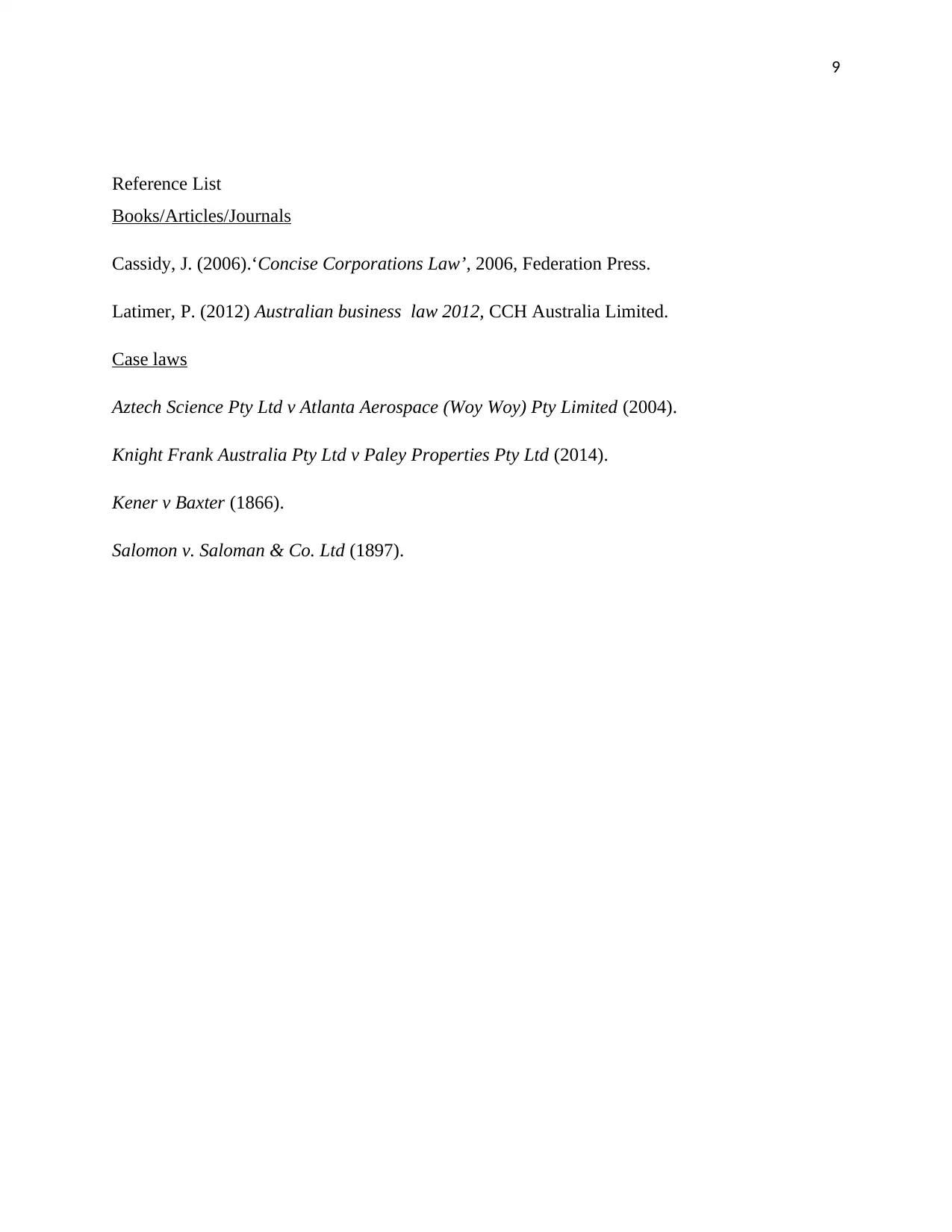
9
Reference List
Books/Articles/Journals
Cassidy, J. (2006).‘Concise Corporations Law’, 2006, Federation Press.
Latimer, P. (2012) Australian business law 2012, CCH Australia Limited.
Case laws
Aztech Science Pty Ltd v Atlanta Aerospace (Woy Woy) Pty Limited (2004).
Knight Frank Australia Pty Ltd v Paley Properties Pty Ltd (2014).
Kener v Baxter (1866).
Salomon v. Saloman & Co. Ltd (1897).
Reference List
Books/Articles/Journals
Cassidy, J. (2006).‘Concise Corporations Law’, 2006, Federation Press.
Latimer, P. (2012) Australian business law 2012, CCH Australia Limited.
Case laws
Aztech Science Pty Ltd v Atlanta Aerospace (Woy Woy) Pty Limited (2004).
Knight Frank Australia Pty Ltd v Paley Properties Pty Ltd (2014).
Kener v Baxter (1866).
Salomon v. Saloman & Co. Ltd (1897).
⊘ This is a preview!⊘
Do you want full access?
Subscribe today to unlock all pages.

Trusted by 1+ million students worldwide
1 out of 9
Related Documents
Your All-in-One AI-Powered Toolkit for Academic Success.
+13062052269
info@desklib.com
Available 24*7 on WhatsApp / Email
![[object Object]](/_next/static/media/star-bottom.7253800d.svg)
Unlock your academic potential
Copyright © 2020–2025 A2Z Services. All Rights Reserved. Developed and managed by ZUCOL.




